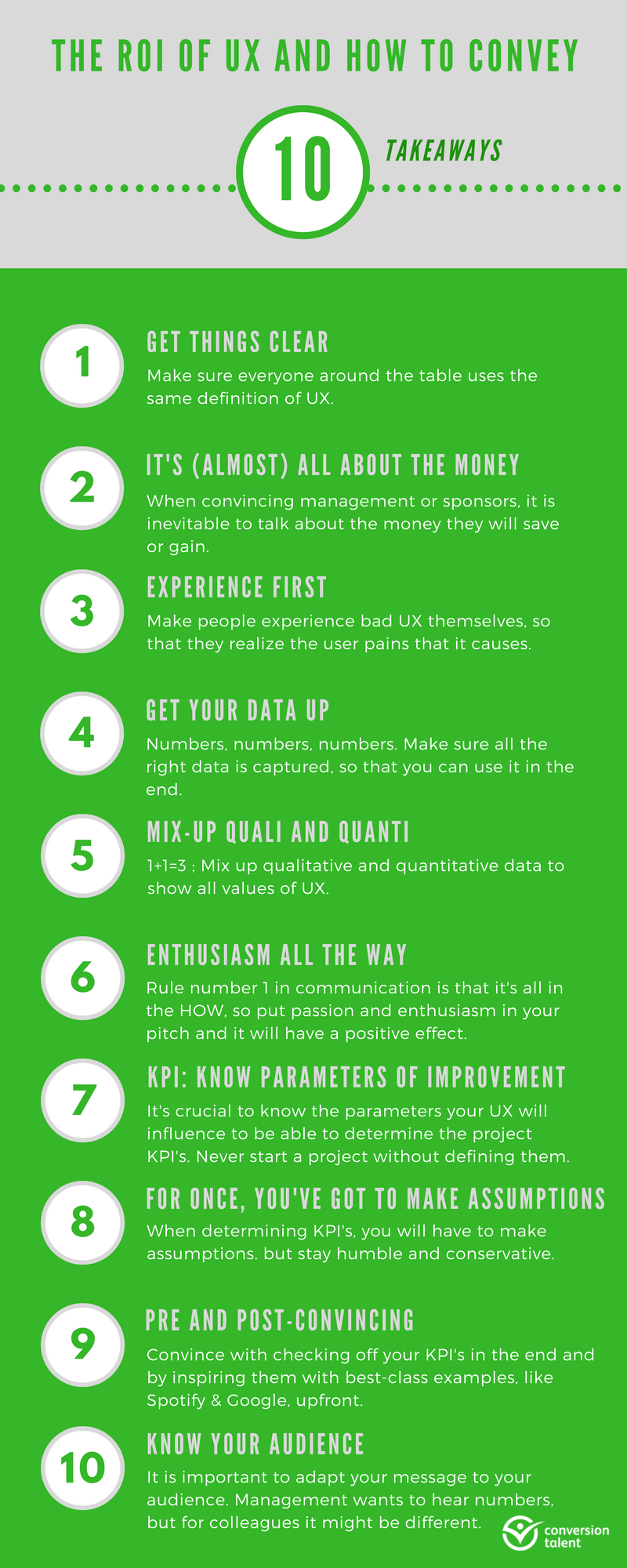UX enthusiasts sharing on how the ROI of UX can be measured and the best way to convey it
A roundtable discussion on “How the ROI of UX can be measured” was held on 8th of June, jointly organised by Conversion Talent and UX Antwerp Meetup. Lisa Riti, the moderator of the discussion, is a Customer Experience Consultant from Conversion Talent. In this blog post, she will share with you a summary of the key takeaways and interesting insights from the discussion. Read on to find out more and don’t miss the infographic in the end!
That evening, we gathered with a few UX-enthusiasts from different backgrounds to discuss the ROI of UX for convincing management of its effectiveness. A variety of views were raised as a result of the different expertise in the room but in the end a clear consensus was reached and that is what we would like to share with you here.
UX has traditionally been incredibly difficult to define due to the wide range of fields in which it is employed, which can often make it a problematic concept to explain to the management team of a company. Our audience agreed quite quickly not to limit the term to digital only, but instead to interpret it as a general customer experience throughout the journey as a whole.
Having cleared this up, it was important to address a few crucial issues before beginning with the formulation of a potential project pitch. No measurements can be done, nor can any ROI be calculated without first having KPIs and data registration in place. To determine the project’s KPIs you will have to make some assumptions to get them SMART. For the credibility of UX, it is important to stay conservative in your estimations, as the worst thing is not being able to live up to the expectations that were set out at the beginning of a project.
There are two types of ROI to prove, pre-project and post-project. It is rather obvious that when a project is finished, you can show the ROI by referring back to your KPIs. However, how do you convince your management to invest in your project upfront?

Here are a few best practices:
First and foremost, it is fundamentally a question of money, cold hard figures often determine whether a project gets off the ground. The main interest of management is often to increase revenue or to cut costs, so if you can show that good UX can contribute to that, the chances are that you will convince those in charge. Nevertheless, not all UX has a direct influence on revenue, so you might have to adapt your message depending on the type of project and audience. When having to convince other people, like IT or marketing colleagues, you might need to use different factors to convince them. Not everyone’s primary motivation will be financial.
A lot of UX-measurements have an indirect effect on revenue. Think about fewer calls to a help desk, a reduction in churn or greater employee efficiency. But how do you explain that in numbers on the company’s balance sheet? No-one from the audience brought this up, but there is such a thing as an ROI-calculator, an example of which being this one from Human Factors (in dollars). ROI-calculators show you how much financial benefit you can expect get from UX improvements.
These tools could help you to determine project KPI’s or your pitch. Knowing that every dollar invested in UX, can bring 2-100$ in return, should make it possible to make a clear case of ROI to your management. However, there is a lot more to UX than just that. UX has an influence on the general customer experience, such as their satisfaction and brand perception. Therefore, quantitative measurements fail to show the bigger picture of the benefits of this type of investment. Our panel was unanimous about the importance of combining both quantitative and qualitative techniques and arguments (such as user testing and interviews) when trying to convince someone of the value of UX.
Another trick from one of our participants was to have managers experience bad UX, in order to have them see the frustration clients undergo when dealing with a poorly designed website. Once they have felt the possible user pains, you could contrast this with the clear benefits of a best-in-class example such as Google or Spotify. We couldn’t think of a single manager that wouldn’t like to have the same level customer experience as them.
With all these lines of argument in mind, you now have the tools to step forward and give a more than convincing pitch on the benefits of UX implementation. This where you must let your force of character shine so that other people can share in your passion for the project. This is where your delivery method is crucial. You must convey a sense of optimism and inspire those on the other side of the table that this is the solution that can help to take the company forward. Such enthusiasm will make your management believe what you believe and bring them onto the same page. As for the rest, the ROI of your UX will speak for itself.
Check out this infographic on the top 10 takeaways from the roundtable discussion!

GUEST AUTHOR
FROM CONVERSION TALENT

Lisa Riti
Customer Experience Consultant
at Conversion Talent

